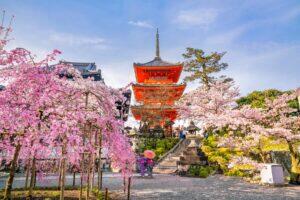Fodor's Expert Review Heian Jingu Shrine
The massive vermilion torii gate of Heian Jingu is one of Kyoto's best-known symbols. Built in the 1890s to commemorate the 1,100th anniversary of Kyoto's founding, Heian Jingu pays homage to the two emperors who bookend the city's era of national prominence: Kammu, who brought the imperial throne here in 794, and Komei, whose reign ending in 1866 saw the sun set on Kyoto's days as the capital. An assertion of Kyoto's unfaded splendor, Heian Jingu was built as a slightly smaller replica of the Imperial Palace, destroyed in 1227. The architecture reveals China's strong influence on the early Japanese court. The gate, the biggest in Japan, is particularly impressive, as are the three elaborate gardens behind the main shrine, conceived by the master designer Ogawa Jihei, which draw on Kyoto's landscaping origins. The complex makes a wonderful backdrop for several annual events, most famously the brazier-lighted plays of Takigi Noh Drama every June 1 and 2, and the Jidai Costume Festival... READ MORE
The massive vermilion torii gate of Heian Jingu is one of Kyoto's best-known symbols. Built in the 1890s to commemorate the 1,100th anniversary of Kyoto's founding, Heian Jingu pays homage to the two emperors who bookend the city's era of national prominence: Kammu, who brought the imperial throne here in 794, and Komei, whose reign ending in 1866 saw the sun set on Kyoto's days as the capital. An assertion of Kyoto's unfaded splendor, Heian Jingu was built as a slightly smaller replica of the Imperial Palace, destroyed in 1227. The architecture reveals China's strong influence on the early Japanese court. The gate, the biggest in Japan, is particularly impressive, as are the three elaborate gardens behind the main shrine, conceived by the master designer Ogawa Jihei, which draw on Kyoto's landscaping origins. The complex makes a wonderful backdrop for several annual events, most famously the brazier-lighted plays of Takigi Noh Drama every June 1 and 2, and the Jidai Costume Festival on October 22.
READ LESS







